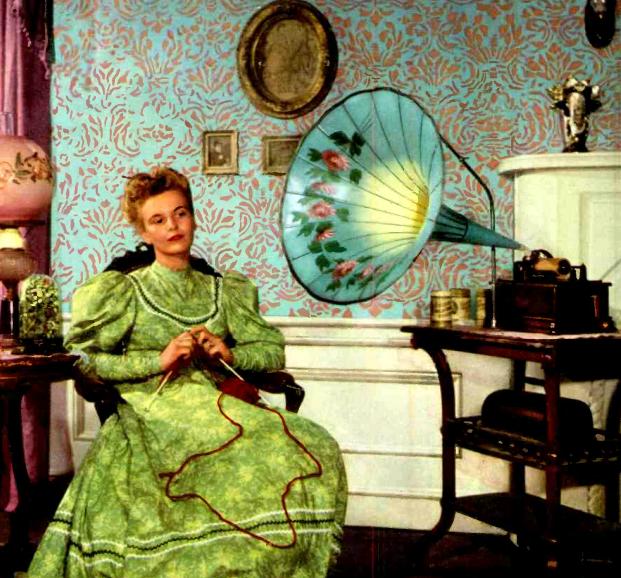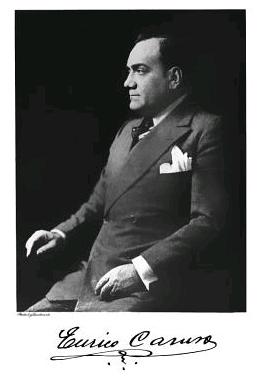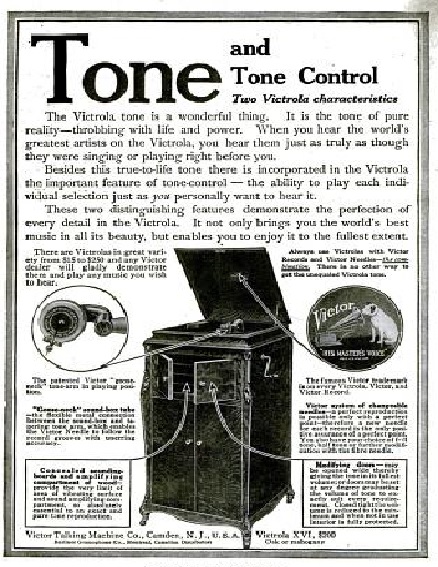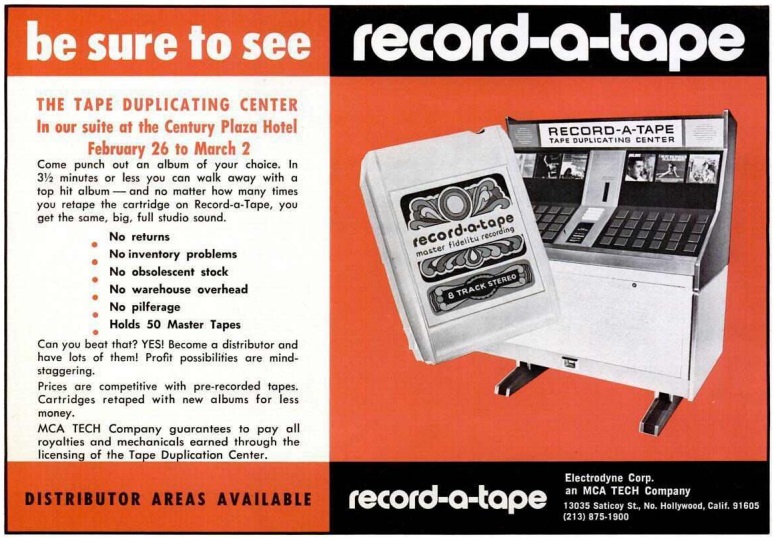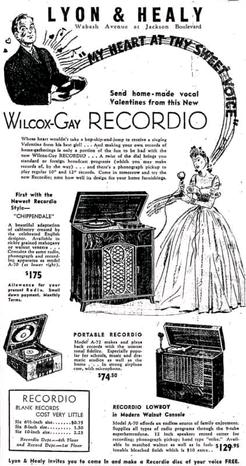This recording of O Holy Night (Cantique de Noel) from February 23, 1916, was Enrico Caruso’s only Christmas recording.
Category Archives: Phonograph History
1890’s Edison Phonograph
Sixty years ago this month, Radio News, November 1955, carried this photo recreating an American living room sixty years before that, in the 1890’s. The photograph was staged by NBC, and the photo taken by Jack Zwillinger. It features an Edison Talking machine.
We’re at a distinct advantage over those in 1955, since we have the capability of listening to many of those early recordings. In 1955, the fragile cylinders would have been too precious to play on the original equipment. Fortunately, many of these recordings, some well over a century old, have been digitized and made available on the internet by the UCSB Cylinder Audio Archive and others. The Library of Congress also has thousands of recordings online, although most of their collection are discs recorded after the turn of the Twentieth Century. To get an idea of what the woman in the photo might have been listening to, this link will allow you to play The Last Rose of Summer, an 1894 Edison recording.
While the ornate horn is obviously an upscale version of the instrument, a phonograph was already becoming affordable to Americans in the 1890’s, and the scene depicted here would not have been extraordinary. By 1900, a basic Edison machine could be had for about $10, with the cylinders going for about $5 per dozen.
Click Here For Today’s Ripley’s Believe It Or Not Cartoon
![]()
1940 Milwaukee Radio and Phono
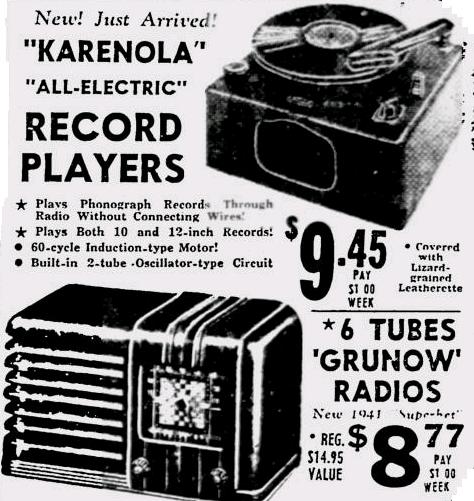 If you were looking for a low-cost radio or phonograph 75 years ago today in Milwaukee, then Economy Boys would be the store to visit. In the store’s ad in the October 24, 1940, issue of the Milwaukee Journal,
If you were looking for a low-cost radio or phonograph 75 years ago today in Milwaukee, then Economy Boys would be the store to visit. In the store’s ad in the October 24, 1940, issue of the Milwaukee Journal,
we see this six-tube Grunow superhet broadcast receiver for just $8.77.
The phonograph, selling for just $9.45, is actually a “phono oscillator.” Instead of including an audio amplifier and speaker, this Karenola model contains a two-tube oscillator circuit, which broadcasts the radio sound to a nearby broadcast radio. Even if the radio is a low-price model without a phono jack, you simply tune to a blank spot on the dial to listen to your records.
At Economy Boys, you could take home either set for just a dollar a week.
Unfortunately, I wasn’t able to pin down the model number of either. Most Grunow radios I’ve seen had wood cabinets, and this one appears to be plastic or bakelite. The Karenola name is probably more familiar as Trav-Ler, since the phonograph was from the Trav-Ler Karenola company of Chicago.
1938 “Live” Broadcast by Caruso
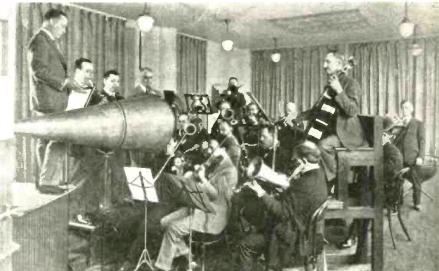 Tenor Enrico Caruso died in 1921, but the January 1938 issue of All Wave Radio magazine noted that the program “The Music You Want to Hear When You Want It,” sponsored by RCA-Victor occasionally carried a “recreated Caruso record” with the voice of Caruso and a recreated orchestral accompaniment. Recording technology had advanced a great deal in the intervening years, as shown by the accompanying photograph of an early recording session, probably taken in the late 1910’s.
Tenor Enrico Caruso died in 1921, but the January 1938 issue of All Wave Radio magazine noted that the program “The Music You Want to Hear When You Want It,” sponsored by RCA-Victor occasionally carried a “recreated Caruso record” with the voice of Caruso and a recreated orchestral accompaniment. Recording technology had advanced a great deal in the intervening years, as shown by the accompanying photograph of an early recording session, probably taken in the late 1910’s.
In Caruso’s day, it was necessary to record the entire performance thought a single horn. The article explains how the violins were placed near the horn for maximum pickup. The frequency range possible meant that the drums wouldn’t be picked up well anyway, so they were situated near the rear.
The soloist’s voice would, however, be picked up well, and the frequency range of the early recordings faithfully preserved Caruso’s voice. Therefore, it was possible to do a recreation broadcast. Using more modern electronic methods, the orchestra could be picked up well. A new live orchestra accompanied a perfect copy of the old recording for broadcast. The conductor wore headphones, listening to the recording as he conducted to keep perfect time.
The result was a new “live” broadcast of Caruso.
1915 Portable Phonograph
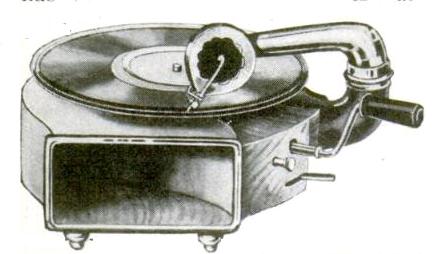 One hundred years ago, Popular Mechanics, July 1915, featured this portable phonograph suited for camping, noting that it was particularly well adapted to use in a canoe or motorboat. Size was reduced by making the horn part of the body. It weighed in at only six pounds and came with a carrying case for easy carrying or storage.
One hundred years ago, Popular Mechanics, July 1915, featured this portable phonograph suited for camping, noting that it was particularly well adapted to use in a canoe or motorboat. Size was reduced by making the horn part of the body. It weighed in at only six pounds and came with a carrying case for easy carrying or storage.
From a handwritten note in the margin of the magazine, it appears that the set was manufactured by the Triton Phonograph Co., 41 Union Square, New York City.
Click Here For Today’s Ripley’s Believe It Or Not Cartoon ![]()
Liberty Bell Sounded, 1915
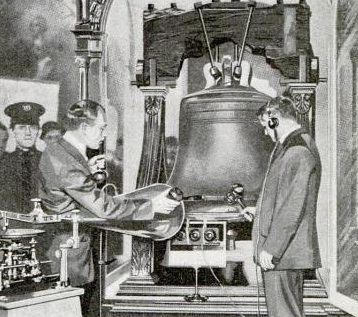 A hundred years ago, the Liberty Bell was sounded for the first time since 1835, and the sound transmitted by telephone to the Panama-Pacific Exposition in San Francisco. The photo here appeared in Popular Mechanics, May 1915. (More details are available in that month’s issue of Electrical Experimenter.) The article also notes that a phonographic recording was made. It was apparently recorded again in 1917, but it appears that neither recording has survived.
A hundred years ago, the Liberty Bell was sounded for the first time since 1835, and the sound transmitted by telephone to the Panama-Pacific Exposition in San Francisco. The photo here appeared in Popular Mechanics, May 1915. (More details are available in that month’s issue of Electrical Experimenter.) The article also notes that a phonographic recording was made. It was apparently recorded again in 1917, but it appears that neither recording has survived.
It was recorded again in 1944 as part of a D-Day broadcast, and there is also a computer-generated recreation of the bell’s original sound. Both of those recordings are available at the National Park Service.
The same issue of the magazine carries an interesting article summarizing how the warring powers of Europe are using wireless as part of the war.
Click Here For Today’s Ripley’s Believe It Or Not Cartoon ![]()
1940 Homemade Phonograph
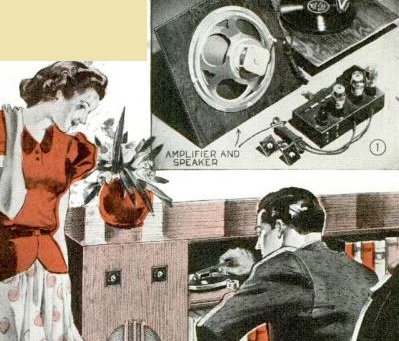 The woman shown here is no doubt admiring the technical skill of the gentleman, who constructed this handsome phonograph into the bookcase. But he has a little secret. He got the idea from the April, 1940, issue of Popular Mechanics, which reveals that no technical expertise whatsoever is required. The turntable came complete with tone arm, and simply needed to be plugged in to the amplifier, which came complete with controls pre-wired. Rounding out the installation was the 12-inch speaker.
The woman shown here is no doubt admiring the technical skill of the gentleman, who constructed this handsome phonograph into the bookcase. But he has a little secret. He got the idea from the April, 1940, issue of Popular Mechanics, which reveals that no technical expertise whatsoever is required. The turntable came complete with tone arm, and simply needed to be plugged in to the amplifier, which came complete with controls pre-wired. Rounding out the installation was the 12-inch speaker.
Click Here For Today’s Ripley’s Believe It Or NotCartoon ![]()
1915 Victrolas
A hundred years ago, Victrola ran this ad showing the features of its top-of-the-line model of phonograph. The ad appeared in the March, 1915, issue of Popular Mechanics. Prices ranged from $15 to $250.
Click Here For Today’s Ripley’s Believe It Or NotCartoon
![]()
The Record-A-Tape: 1971
As far as I can tell, this is an idea that never made it. Other than this ad which appeared in Billboard on February 27, 1971, and on other dates, I’ve been unable to find any reference to the Record-A-Tape. The machine was loaded with up to fifty different albums. When a customer wanted to purchase one on 8-track, the machine would crank it out a copy in 3-1/2 minutes. The distributor would take care of royalties, the retailer didn’t have to worry about inventory, and the customer would never find anything out of stock.
Click Here For Today’s Ripley’s Believe It Or NotCartoon
![]()
The Wilcox-Gay Recordio: 1940 Home Recording
75 years ago, it was possible to do audio recording at home, but it was a pricey proposition. Magnetic recording didn’t really become possible until after the war, and very few homes would have owned a tape recorder prior to 1970. But for someone who really wanted to immortalize their voice in 1940, it was possible to purchase the Recordio, shown in this advertisement from the Chicago Tribune, January 28, 1940. Just in time for Valentine’s Day, the ad shows a well-dressed young woman recording a “home-made vocal Valentine,” presumably for the love-struck gentleman shown at the top of the ad.
The deluxe model into which the young woman is singing sold for $175, and included a radio covering standard broadcast and short wave. The ad noted that it was possible to make records off the air, and the unit also functioned as a player for purchased records. The same electronics in a more modest lowboy console was also available for $129.95, and a portable unit (apparently without radio) was available for $74.50.
That wasn’t the only expense involved, however. The blank records ranged in price from 75 cents for six 6-1/2 inch disks, up to $2.25 for the same number in the 10-inch size.
The final product, which could of course not be erased, meaning that only one take was available, was a standard 78 RPM record that could be played on any phonograph, such as that owned by the gentelman shown at the top of the ad.
The manufacturer, Wilcox-Gay Corp. of Charlotte, Michigan, had been in business since 1910, making radios and dictation machines. The Recordio came out in 1939, and reportedly sold 25,000 units the first year. The company continued to make similar machines in the 1950’s, but later models included a magnetic recorder in the same unit, which would allow recording a master before cutting the disk. If you search YouTube, you’ll find surviving examples of the disks, such as this one of some aspiring musicians offering their rendition of “My Bonnie Lies Over the Ocean.”
Musicians such as Les Paul and Johnny Cash were known to have used Recordios at some point in their careers.
Click Here For Today’s Ripley’s Believe It Or Not Cartoon
![]()

